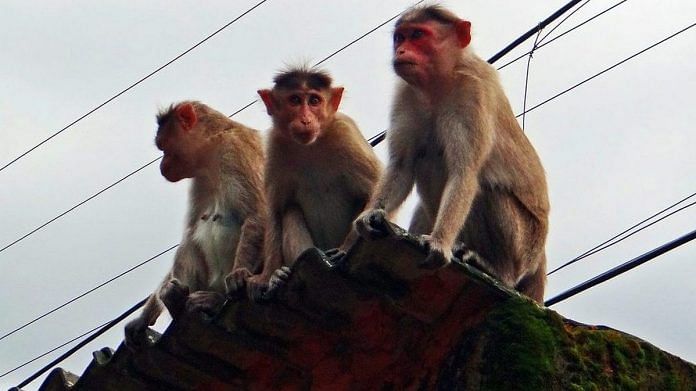Thank you dear subscribers, we are overwhelmed with your response.
Your Turn is a unique section from ThePrint featuring points of view from its subscribers. If you are a subscriber, have a point of view, please send it to us. If not, do subscribe here: https://theprint.in/subscribe/
Rhesus monkeys are most hardy and adaptable non-human primates. At present because of human folly free ranging monkeys have become commensal. There is a bitter competition between monkeys and humans for space, food and water. The interactions are mild when humans are aware that they are staying or visiting monkey areas. Interactions turn hostile when humans do not understand the body language of monkeys, unknowingly take over monkeys space, eliminate their natural food and water sources, cross the path of monkeys who are agitated, go near baby monkeys or are around when adult males are fighting for food and females as monkeys could divert their aggression towards humans around. Such interactions result in monkeys growling, scratching, hitting, pushing or biting humans.
Some Facts
Humans can never win against agitated monkeys. Under stress females become sexually maturer faster leading to sudden increase in their numbers. An alpha male walking with his tail up and curled at the tip can lead the group away from or towards aggression. Monkeys do not forget and have very sharp canines and claws.
A peaceful monkey group will follow a set routine, have members grooming one another, foraging, one-, two- and three-year-old youngsters playing around, females with their new bourns suckling or infants on and around their mothers. Many monkeys play mounting. All mountings are not sexual. For youngsters its play acting and for adults it’s a sign of dominance. A monkey baring his clenched teeth is scared and not aggressive. A monkey making ‘Kho- Kho’ sound is only bluffing aggression.
Free ranging monkeys live in forests, along the canals and old abandoned forts etc. Commensal monkeys are in residential colonies, bazars, temples, hospitals, schools etc.
Monkeys live in groups. The sub-adult males leave their birth group, move around singly or in twos and threes till they manage to get into a new, unknown group. During this process they move through human areas and would not stay there if there are no attractants like free food, open garbage or unguarded water source.
To recognize the sex of monkeys around look for testicles between hind legs or mammary glands on their underside. Recognize the newborns, a year-old infant, 2and 3 year old adolescents, 3 to4 year subadults and adults by their size.
How to live in monkey areas
- Know the alpha male, core area where they spend most of their time, home range where they roam around and forage, daily routines, natural foods, water sources etc and avoid hostile interactions.
- Don’t run, hurt, hit or tease them, go near a baby monkey. In case you cannot decide what to do stand absolutely still for some time and then walk away calmly. Do not touch or pat a monkey. Never look in their eyes that is considered challenging.
- Enrich their area. Plant monkey friendly trees and ground cover. Create water source. Provide articles like small rocks to crack open nuts, probes to eat termites and ants etc.
If monkeys come to reside in your area
-
- Know alpha male, daily routines, core area, foods& water sources and foraging routes to avoid hostile interactions.
- Don’t provide food, walk through the group, go near a baby monkey, touch or pat any monkey, look in their eyes, shout or hit any monkey.
- Manage the garbage, secure doors and windows, plant thorny shrubs, put signages, create awareness.
If a group of monkeys visit your area
- Identify what is attracting monkeys to your area, if food and /or water are freely available and if garbage is lying in the open.
- Don’ts feed the monkeys or keep water source accessible to them or garbage out side.
- Create awareness about the body language of monkeys to avoid mishaps.
If one- two or three monkeys visit your area
- Identify if they are sub adult males.
- Manage your garbage.
- Don’t provide food, go too near, look in their eyes or hit it/them.
- Ignore them. Most probably they are just passing through your area. They would leave the area sooner if there are no attractants around.
While crossing a monkey area regularly
- Never look in their eyes, touch, pat, hit tease or walk near a baby monkey,
- Keep safe distance, walk calmly, talk softly, ignore them.
If you come across a monkey suddenly
- Do not panic.
- Realize the monkey is passing through, give him the right of passage
- Do not look in his eyes
- Standstill / walk away calmly
Last Words
Monkeys are wild animals and clubbing them with domesticated animals like cows and dogs is creating management problems. Monkey management must be the responsibility of forest department and not municipalities. The work force must be naturalists and not contractors.
Let’s admit that monkeys are in agitated state. Let’s calm them by leaving them aside so that they leave you aside.
These pieces are being published as they have been received – they have not been edited/fact-checked by ThePrint.


